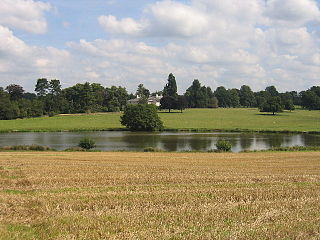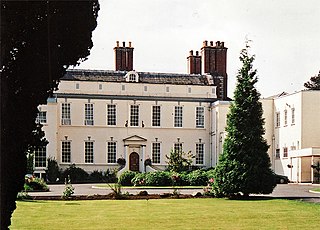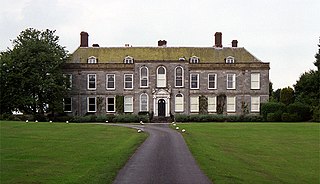
Wormleybury is an 18th-century house surrounded by a landscaped park of 57 ha near Wormley in Broxbourne, Hertfordshire, England, a few miles north of Greater London. The house was rebuilt in the 1770s from an earlier house built in 1734. The house is a Grade I listed building. The garden is well known for its historic rare plant collection. There is a crescent shaped lake in the grounds, bordered by woods on three sides.

Burton Agnes Hall is an Elizabethan manor house in the village of Burton Agnes, near Driffield in the East Riding of Yorkshire, England. It was built by Sir Henry Griffith in 1601–10 to designs attributed to Robert Smythson. The older Norman Burton Agnes Manor House, originally built in 1173, still stands on an adjacent site; both buildings are now Grade I listed buildings.

Berkswell Hall is a 19th-century country house at Berkswell, formerly Warwickshire now West Midlands, now converted into residential apartments. It is a Grade II* listed building.

Menabilly is a historic estate on the south coast of Cornwall, England, situated within the parish of Tywardreath on the Gribben peninsula about 2 miles (3.2 km) west of Fowey.

Wootton Lodge is a privately owned 17th-century country house situated at Wootton near Ellastone, Staffordshire, England. It is a Grade I listed building.

Tyttenhanger House is a 17th-century country mansion, now converted into commercial offices, at Tyttenhanger, near St Albans, Hertfordshire. It is a Grade I listed building.

Milton Hall near Peterborough, is the largest private house in Cambridgeshire, England. As part of the Soke of Peterborough, it was formerly part of Northamptonshire. It dates from 1594, being the historical home of the Fitzwilliam family, and is situated in an extensive park in which some original oak trees from an earlier Tudor deer park survive. The house is a Grade I listed building; the garden is Grade II*.

Haughton Hall is an early 18th-century country house situated at Haughton Lane, Shifnal, Shropshire, England now converted for use as a hotel. It is a Grade II* listed building.

Downton Castle is a grade I listed 18th-century country house in the parish of Downton on the Rock in Herefordshire, England, situated about 5 miles (8.0 km) west of Ludlow, Shropshire.

Stockerston Hall is a late-18th-century English country house in Leicestershire, near the town of Uppingham, Rutland. It is a Grade II listed building.

Carlton Curlieu Hall is a privately owned 17th-century country house at Carlton Curlieu, Leicestershire. It is the home of the Palmer family and is a Grade II* listed building.
The Monoux Baronetcy, of Wootton in the County of Bedford, was a title in the Baronetage of England. It was created on 4 December 1660 for Humphrey Monoux. The second Baronet sat as Member of Parliament for Bedfordshire. The third Baronet was Member of Parliament for Bedford. The fourth Baronet sat as Member of Parliament for Tavistock and Stockbridge. The title became extinct on the death of the seventh Baronet in 1814.
The Payne Baronetcy, of St Christopher's in the West Indies, was a title in the Baronetage of Great Britain. It was created on 31 October 1737 for Charles Payne. According to some sources that title became extinct on the death of the second Baronet, Sir Gillis Payne, in 1801. Sir Gillis was in a relationship with a farmer's daughter, Maria Keeling. They apparently married in 1761 although several children had been born before this date. Peter Payne was the eldest son born after the marriage and would normally have succeeded in the title. However, he allowed his eldest brother John Payne to assume the title, although John was illegitimate. John died in 1803 when his son Charles assumed the title. However, in 1828 Peter Payne raised the question in the courts over who was the rightful baronet. The Court of Chancery declared that he was the rightful heir to his father, but this was overturned by the Lord Chancellor in 1829. Nonetheless, during his lifetime Sir Peter was universally acknowledged as a baronet. Most reference books on the British nobility and baronetage include the title, although they describe it as being in dispute between rival branches of the family. Charles Robert Salusbury Payne, the supposed sixth Baronet, appears to have discontinued the claim around 1900.

Aldenham Park, also known as Aldenham Hall, is a late 17th-century country house in Morville, near Bridgnorth, Shropshire, England which stands in 12 hectares of parkland. It is a Grade II* listed building.
Sir John Cope, 6th Baronet (1673–1749), of Bramshill, Hampshire, was a British banker and Whig politician who sat in the English and British House of Commons for 36 years from 1705 to 1741. He was a Director of the Bank of England from 1706 to 1721.
Sir Monoux Cope, 7th Baronet was a British politician who sat in the House of Commons between 1722 and 1747.
Sir Jeremy Sambrooke, 4th Baronet of Bush Hill, Enfield, Middlesex, was a British landowner and Tory politician who sat in the House of Commons from 1731 to 1740.
Sir Humphrey Monoux, 4th Baronet of Wootton House, Bedfordshire, was a British landowner and Tory politician who sat in the House of Commons from 1728 to 1741
Sir Samuel Vanacker Sambrooke, 3rd Baronet of Bush Hill, Enfield, Middlesex, was a British landowner and politician who sat in the House of Commons as MP for Bramber and Great Bedwyn.
Sir William Gostwick, 4th Baronet was an English Whig politician who served as MP for Bedfordshire from 1698 to 1713.












